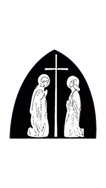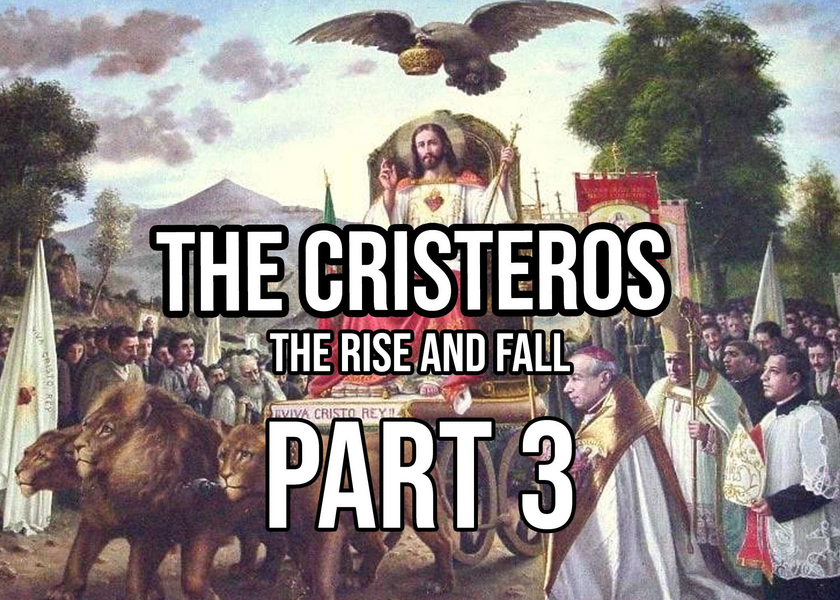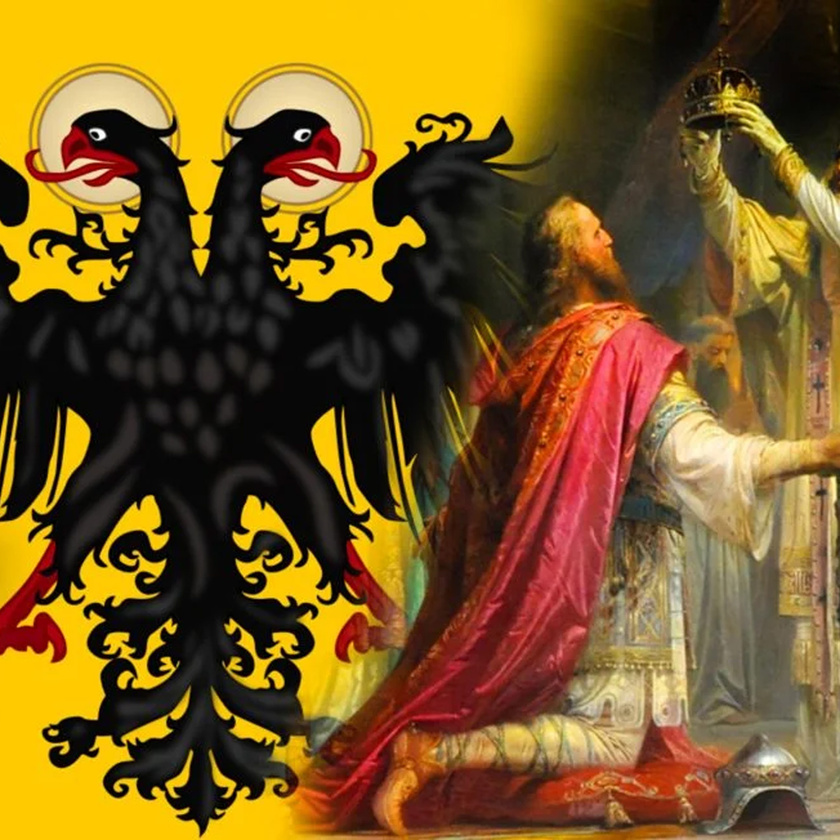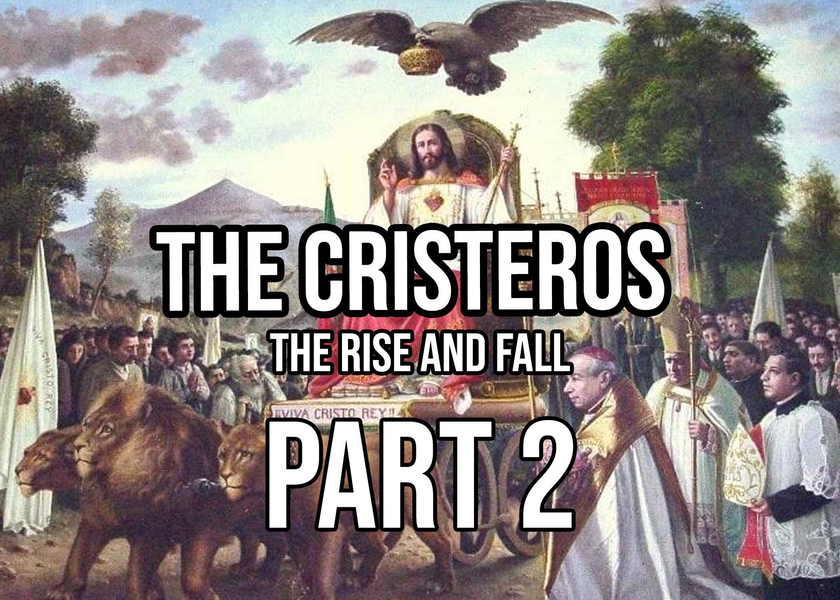The Rise and Fall of the Cristeros
Part III
By Mark Fellows
“The country is a jail for the Catholic Church. In order to be logical, a Revolution must gain the entire soul of a nation. They will have to open a jail for each home, and they don’t have enough handcuffs or hangmen to bind up the hands and cut off the heads of the martyrs. We are not worried about defending our material interests, because these come and go; but our spiritual interests, these we will defend because they are necessary to obtain our salvation.”[1]
The body of the man who wrote those words, Anacleto Flores (“El Maestro”), was dumped on an untended patio after his execution. Also dumped were the bodies of Juan Padilla and Ramon and Jorge Vargas, who had sheltered Flores from government persecution.
The bodies were taken home by family members and a period of mourning began. Doña Elvira, the mother of Ramon and Jorge, quieted a crying relative by saying, “You know that our mission as mothers is to raise our children to heaven.” The Vargas’ had sheltered many Catholics during the persecutions without mishap. Did they regret sheltering Anacleto Flores? Jorge’s sister Maria Louisa recalled:
“We had already had in our house various priests and a group of young seminarians, but never a chief of the Cristeros. The responsibility of lodging him was enormous, but it was impossible to close the doors against him—this, never.”[2]
The doors were also open at the Flores home, where hundreds of mourners came to touch the body of El Maestro and console his young widow and children. Did Senora Flores regret her husband’s life? Gathering her sons around their father’s body she told them: “Look. This is your father. He has died defending the Faith. Promise me on his body that you will do the same when you get older if God asks it of you.”
The next day thousands of Catholics ignored the law and police intimidation to join a procession with the bodies of the martyrs. They prayed and sang hymns to Christ the King and the Virgin of Guadalupe as they slowly walked to the cemetery in Mezquitan for burial.
The police wisely did nothing to prevent the (technically illegal) procession. In a face saving move the government claimed the executions occurred because the martyrs conspired to kill an American in order to stir up trouble between the United States and Mexico – as if the government needed any help doing that.[3]
The Revolution’s statement was a lame slander at best – not even the murdered American’s wife believed it. The Church gave her verdict in November 2005, when Anacleto Gonzalez Flores was beatified (along with Padilla, Vargas, and other Mexican martyrs).
The Clergy and the Cristeros
In August 1926 Calles had confidently predicted that the Cristero uprising would be repressed within weeks. “It will be less a campaign than a hunt,” boasted General Ferreira.[4] Nine months later the General promised an end to armed conflict by Midsummer 1927. But the peasant guerillas kept winning battles.
Calles blamed their stubbornness on the Church, whom he claimed was aiding and abetting the Cristeros in their rebellion. Few statements – even from Calles - could have been more inaccurate. It was true many priests were martyred, but rarely because they supported the Cristeros. The clergy was considered dangerous, and of course to the Revolution they were, though not in a military sense.
Here was another case of Calles and the Mexican government not comprehending reality. They thought if they strung up enough Cristeros from telephone poles – and there are pictures showing Mexican Catholics dangling from nooses on telephone poles, the dead bodies stretching to the horizon – the Catholics would be intimidated.
In fact the sight of martyrs for the faith seemed to energize the Cristeros and their sympathizers, whose stubbornness seemed limitless during the three-year war.
Calles also misunderstood the clergy. He assumed priests and Cristeros were thick as thieves, and that his persecution of the clergy would weaken the Cristeros. Consequently, Father Jose Genaro Sanchez of Jalisco was hung, Father David Uribe was shot in April, 1927, and Father Mateo Correa Magallanes was executed for not telling government officers the contents of the confessions some Cristeros made to him.
The executions also involved torture and mutilation, as in the case of Father Sabas Reyes who “was suspended for three days from a portico of his church and jabbed with bayonets by soldiers, who finally cut off the soles of his feet and then forced him to walk to the cemetery, where they shot him.”[5]
Eighteen non-combatant priests were executed during 1927. None of them was aligned with the Cristeros, except in the Revolution’s fevered imagination. The few priests that aided the Cristeros, usually as military chaplains, were criticized for so doing by their fellow priests.
According to Father Adolfo Arroyo:
“The overwhelming majority of the bishops and priests, displaying a criminal degree of conformism, wallowed in an accursed inertia, all expecting sheer miracles from heaven to give liberty to the Church.
“They were all content to give exhortations and say a few prayers. The priests, more strict than ever, mostly had recourse to theology and, without further consideration, announced the illicit nature of the violent struggle in defense of the Church.[6]”
In sermons the Cristeros were routinely referred to as “cattle thieves.” This was a baffling criticism to many Cristeros, who waged war in order to reopen the churches so the priests could do their jobs. After pondering the matter, one Cristero replied:
“We came across an obstacle which we would never even had imagined: the very Fathers forbade us to fight for Christ, for the religion our fathers taught us and then reaffirmed for us in baptism, confirmation, and our first communion. And this was when we were fighting chiefly to defend them.
“You must not have recourse to violence, they would tell us; a Christian must be humble and patient and let himself be struck.
“We rebels wanted to know why, if it was true that the only path open to the soldiers of Christ was to turn the other cheek, they (the clergy) were not going to surrender so that they could die like martyrs straight away. This was another mystery for us rebels.”[7]
Some Cristeros believed the clergy were cowards. In fairness however, a priest’s ministry rarely involves armed warfare. His obligation is to administer Sacraments to souls. He must protect this obligation for the sake of his parishoners. Of course a priest can fulfill his obligations without calling other Catholics “cattle thieves.”
Yet it was also true that priests in Mexico were not having an easy time of it either - except for those who were priests to government families.
The way it worked was that the government employee would give in to his wife’s requests to hear Mass and bring a priest to the house. In some homes this became a regular event, with meals and socializing afterwards. So the government, ironically, protected certain priests.
Other priests lived like Cristeros: a hand to mouth existence under difficult circumstances. They lived in hiding and traveled dark, lonely roads to minister to a Catholic country starving for them. These priests were always in danger of being caught by the government and shot, or worse.
Still other priests remained with their parishes even under threat of death by the government, who had a policy of removing priests from their rural parishes and relocating them in urban centers. The government thought the absence of priests would weaken the resolve of the Cristeros and their sympathizers, who all lived in the country.
The priests who defied this government policy were not necessarily Cristero sympathizers – they were simply brave priests who refused to abandon their flocks in an hour of need, and sometimes paid for this decision with their lives.
Some of the priests who denounced the Cristeros were sincere. Others found it expedient to publicly side with the government and condemn the Cristeros, assuming the rebellion would be short and their clerical careers would be long. Still others may have simply been carrying out orders.
The episcopate had not lost patience in waiting for the government to come back to the bargaining table. To encourage this the Mexican Church attempted to prove its good faith by officially deploring Catholics being violent against the government. Privately some bishops were annoyed the Cristeros were being so impatient.
Another point of conflict between the Cristeros and the Church in Mexico was the bishop’s refusal to provide military chaplains to the Cristeros. This led a Cristero named Miguel Gomez Loza to observe:
“The Fathers in these parts do not approach our soldiers; they say it is because they do not want to commit themselves or they are afraid of their superiors. Those who have the most right to, and the most need of spiritual succour, are the most abandoned.”[8]
Clergy who aided the Cristeros were small in number; perhaps forty priests in the three-year war. The rest of the priests in Mexico, some 3,600, were either hostile to the Cristeros or refused to aid them for various reasons.[9]
This provoked bitterness in the ranks. Some Cristeros called the clergy cowards. Yet if this charge was at least in part born of frustration, frustration yielded in turn to indomitable resolve:
“Without their (the clergy) permission and without their orders we are throwing ourselves into this blessed struggle for our liberty, and without their permission and without their orders we will go on until we conquer or die.”[10]
The clergy had options. The majority of them left their parishes and resettled in larger towns, where persecution was mild and one could eat lunch with government men. It was a comparatively pain free life for priests and served the government purpose of removing priests from rural areas where Cristeros lurked.
Most Cristeros’ believed that fighting for their religion was the only honorable choice. Some longed for martyrdom. A group of older men joined the ranks saying: “We are going, we old ones who are good for nothing, to give our lives to God.”
Others declared, “We must win Heaven now that it is cheap,” and “How our grandfathers would have loved to win glory like this! And now God is giving to us! I’m off.”[11] It is easy to claim the desire to be a martyr. When the opportunity came, however, many Cristeros’ backed up their words with the courage of true martyrs.
Twenty-seven Cristeros were summarily executed at Sahuayo. Only Claudio Becerra was spared, because he was a boy. Later he wept at the tomb of the twenty-seven, saying, “I am sorry that God did not want me as a martyr.” Age was not always a barrier to martyrdom: when young Honorio Lamas was executed with his father, he whispered to his mother before the final volley, “How easy Heaven is now, mother!”
Cosme Valencia was executed for refusing to serve in the federal army. His last words: “I want the life of the soul, not that of the body.” Cristero Norberto Lopez was offered a pardon if he enlisted in the army. He refused, saying, “Ever since I took up arms I have had the intention of giving my life for Christ, and I’m not going to break the fast at a quarter to twelve.”
Here is an account by Josefina Arellano about the death of her young brother-in-law:
“Silverio…pulled back the blanket that covered the doorway and greeted the Government by saying softly, ‘Long live Christ the King!’, and when the echo of his voice died away he was already on his way to receive the martyr’s palm and crown, for he had always said that he was a Catholic and had no other interest than the love of Christ.
“A few moments later, I drew back the blanket to go out, leaving the little ones in the arms of Domingo (her husband) to go out to die. Treading on the dead bodies, I stopped in the doorway, my God, what did I see? Above the stone wall many rifles were pointing at me, my eyes clouded over, my body trembled, but I remembered that the moment was for me, I imagined the crown and I almost touched the palm.”[12]
Those many who witnessed the deaths of their loved ones reacted with supernatural detachment: “It was a great adventure, so great and so noble, we were so happy at that time,” recalled Cristero Ignacio Villanueva, “Our Lord has been pleased to confer the martyr’s crown.”
There was grief and bitterness as well, but even these reactions were penetrated by the light of grace bestowed. One relative declared:
“You and I deplore from the bottom of our hearts the death of these men who offered in good faith their lives, their families and their worldly interests, who shed their blood for God and our beloved country, as true Christian martyrs do…
“Their blood, united with that of Our Lord and with that of all the martyrs of the Holy Ghost, will obtain for us from God the Father the blessings that we hope for on Earth and in Heaven; blessed are those who die for the love of God who made Heaven and Earth...not like the false gods of Plutarco Elias Calles and other madmen seduced by Satan.”[13]
Historian Jean Meyer remarked:
“The calm confrontation of death by the Cristeros who were taken prisoner always made an impression on the Federals...Literature, songs, and the cinema have popularized this image of the virile Mexican, indifferent to life and death, and of his murderers, weeping out of admiration for him.
“Although the death of the Cristeros might be considered as resembling this model, its content and significance were entirely different, for it was an experience of communion with God and not a posture before men. One might then say of the Cristero movement that, rather than a Crusade, it was a collective ‘imitation of Christ’, the sacrifice of the Cristeros rather than the pursuit of the death of the persecutors.”[14]
The Battles
The Cristeros also resembled an army, albeit a disorganized one. As time went on their tactics changed from guerrilla fighting to coordinated attacks on rural federal strongholds. Calles was dismayed when a force of Cristeros attacked and captured San Francisco del Rincon, a good-sized town fortified by federal troops. The Cristeros split their army into three forces, each of which attacked and captured three military strongholds in the town.
Hardest to fall was the town hall. The Cristeros crashed the front door in with pickaxes and crowbars, and then engaged in mortal hand-to-hand combat in each room of the building. After a brutal struggle the federales fled.
The next day a Cristero force led by Father Jose Reyes Vega led an assault against a larger federal force near Arandas. After a three-hour battle, the Cristeros’ superior knowledge of terrain, combined with fearsome cavalry charges, defeated the federal army again.
The following month an elite four hundred man federal cavalry unit sought to drive two hundred Cristeros from San Julian, a town they occupied. The federales rode into San Julian to utter quiet. Believing the Cristeros had fled, they proceeded to the center of town, and were withered by a concentrated volley of musket fire.
The Cristeros, low on ammunition as always, had been instructed not to fire until the enemy was upon them. The federales fell back, then attacked again. So it went for some time, Cristero rifle fire becoming sporadic as they ran out of ammunition.
A cloud of dust approached the bullet-strafed town. The federales saw horsemen carrying red, white, and green Mexican flags and cheered; they now had enough reinforcements to take the town.
As the cavalry came closer another cheer went up: Viva Cristo Rey! For it could now be seen that the Mexican flags were emblazoned with the image of Our Lady of Guadalupe: the reinforcements were Cristeros. The federales broke rank and fled in a panic.[15]
Perhaps the most spectacular Cristero success in 1927 occurred in the state of Michoacan. The Cristeros were led by Luis Navarro Origel, who, when he took up arms, declared: “I will kill for Christ those who are killing Christ, and if no one follows me in this enterprise I will die for Christ.”[16]
He commanded a series of victories, including a three-day battle in June that involved one thousand Cristeros. Then the rains started, and most of the Cristeros went home to tend their crops.
They came back in the fall and the string of victories continued. The most spectacular triumph occurred when Navarro’s men besieged seven hundred government troops at Canada de Ticuilucan. After losing two hundred men the federales were abandoned by their general who galloped away on horseback.[17] By the end of the year large portions of Michoacan had been removed from government control.
A few weeks after Anacleto Flores was executed, Father Vega led an assault against a train carrying 400,000 pesos. Track was torn up and the train derailed. A three-hour battle ensued between the Cristeros and federal troops on the train. Also present were dozens of civilian passengers, used as human shields by federal troops during the fighting.
When Father Vega’s brother was killed in the fighting, Vega became enraged and ordered the cars set on fire. About four dozen people were burned alive. The Cristeros got the money and turned most of it over to a rich Catholic who said he would buy arms with it. The Cristeros never saw the money again.[18]
Calles was enraged by the Cristeros victories, and used the train incident for its full propaganda value, neglecting to mention his army’s use of Mexican citizens as shields, or the fact that many Cristeros were also critical of Father Vega’s actions.
Calles used the incident to expel the remaining Mexican bishops from the country, and to introduce a new government program called Reconcetracion, or Reconcentration. Rural villages were emptied, and the villagers were sent to large cities to survive as best they could.
After plundering the empty village, the army burned everything to the ground. Harvests were sold or destroyed. Animals were sold or machine-gunned. The Revolution that had proclaimed itself champion of the poor was now destroying them.
Huddled together in hot cities in the most unsanitary conditions, many refugees contracted typhoid or small pox. They were mocked by federales, who grabbed rosaries and scapulars from the refugees, and after profaning them and hurling them on the ground, shouted: “Fanatics! What good does all that stuff do?”[19]
Calles’ plan was simple: to destroy the food chain the Cristeros relied on, and turn their sympathetic countrymen against them. The Reconcentracion certainly halted Cristero momentum, but here again the government miscalculated, for army brutality converted many of the refugees from Cristero sympathizers to actual Cristeros.
This dynamic was also lost on an American observer, who reported that the Reconcentracion military campaign would end the Cristeros rebellion. Carleton Beals, a leftist writer who was firmly pro-government and anti-Church, witnessed the horrible sufferings of the refugees and concluded:
“The sorry state of affairs in Mexico cannot be attributed to the Catholics but to the military chiefs and irresponsible bandits…In the entire country civil law has disappeared and life is not worth a straw; property belongs to those who gave arms.”[20]
The wanton destruction of crops, land, and animals drove up food prices, and the brutal treatment of refugees caused plagues to spread. The Reconcentracion was halted; the refugees were returned to what - if anything - was left of their homes, and ordered to reseed their fields.
















